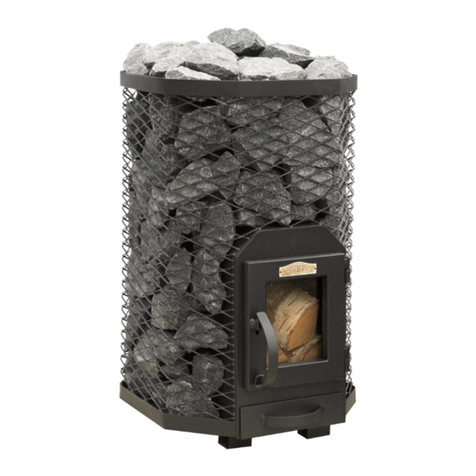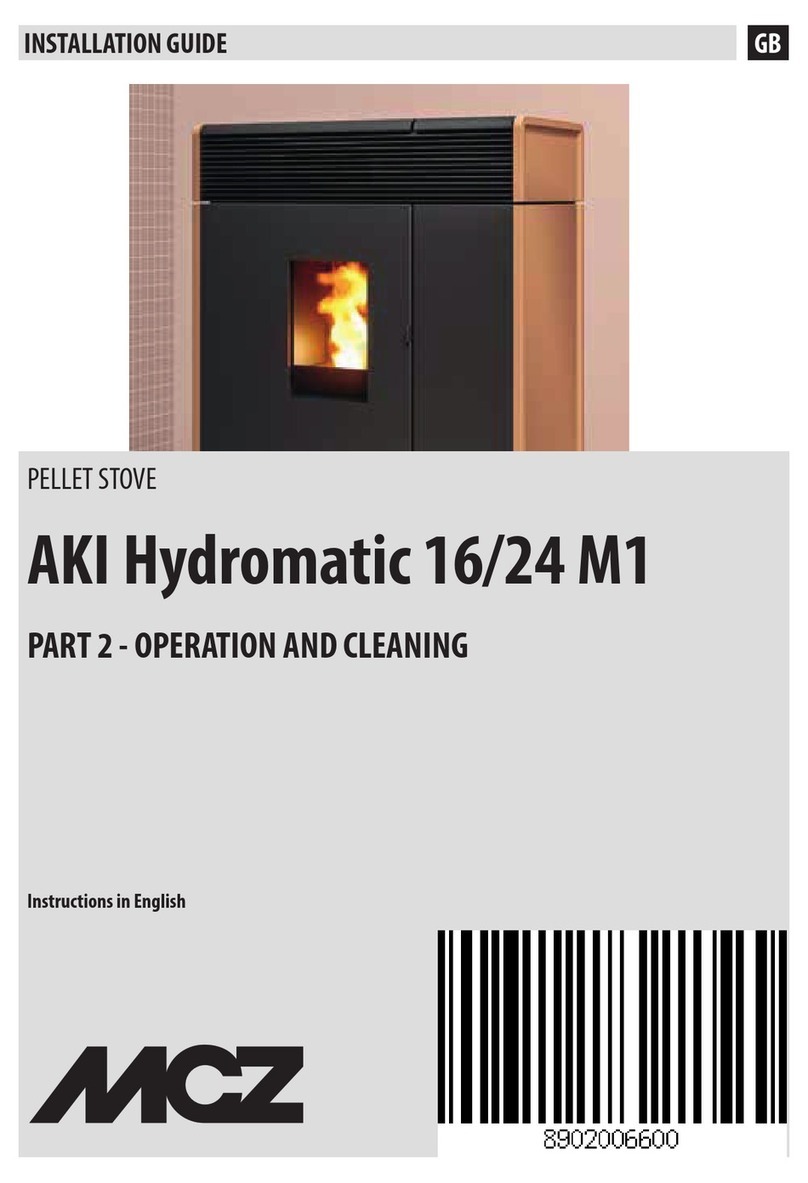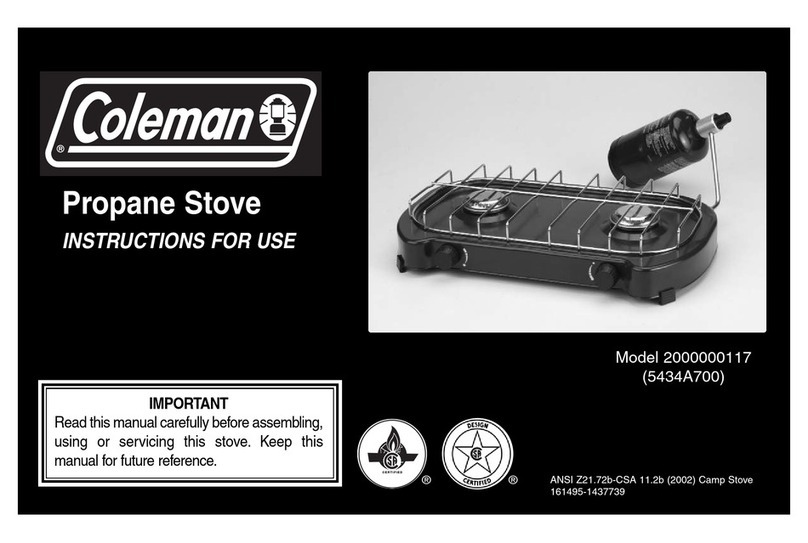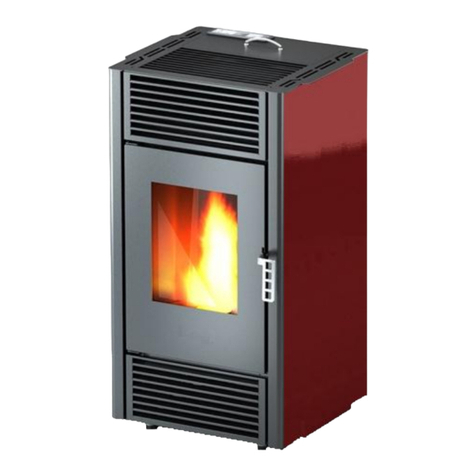Hegrom Compact C-4 User manual

WELCOME to the HERGÓM family.
Thank you for choosing our built in CAST IRON STOVE.
All its pieces are manufactured in cast iron which guarante -
es that it will serve you for many, many years. All our stoves are
manufactured in special boiler plate.
We are sure that your new CAST IRON STOVE will be enti -
rely to your satisfaction.
To possess a HERGOM STOVE shows an eye for excep -
tional quality.
Please, read all the manual. Its aim is to make you familiar
with your STOVE giving guidelines for its installation, operation
and maintenance which will be very useful. Keep it and refer to
it when necessary.
If after reading this manual you need any further clarification
please contact your normal supplier or call the factory directly.
INDUSTRIAS HERGÓM, S.A., does not take any responsibility whatsoever for the dama-
ges caused by or resulting from alterations to its products that have not been authorised in wri-
ting or for defective installations.
Furthermore, it reserves the right to modify its finished products without prior war-
ning.
Industrias Hergom, S.A., with registered offices in Soto de la Marina - Cantabria Spain, of-
fers a TWO-YEAR warranty for all its products.
The geographical coverage for this warranty only includes the countries in which Industrias
Hergóm, S.A. has a subsidiary company or an official importer that carry out the distribution of
its products and where the Community Directive 1999/44/EC is obligatory.
The warranty will come into force as from the date of the purchase of the product stated on
the warranty card and only covers the damages or breakages due to manufacturing defects or
faults.
I M P O R T A N T
13

The safety and performance of the C-4 stove will greatly de-
pend on its correct installation.
It is very important to install the stove correctly.
To ensure that your stove is installed correctly it is advisable
that this job is done by a professional.
Although the Compact C-4 stove gives out heat by radiation,
directly heating walls, ceilings etc. this is mainly done by forced air
convection thanks to the ventilators incorporated in the stove which
direct the heat to the furthest parts of the room.
A. ASSEMBLY
To install the Compact C-4 stove you will first have to build a
chimney (“draught”) with suitable metal tubes until it is 1 metre abo-
ve the highest part of the roof.
If there is already a chimney, then the stove has to be installed
by extending the already existing chimney using a tube to join the
smoke exit of the apparatus to the existing chimney.
It is very important that the joints between the sections of the
chimney are well sealed. (See fig. 11).
B. POSSIBILITIES OF A HOT AIR EXIT (Fig. 2.)
EXIT THROUGH THE FRONT UPPER GRILL (A). Turn the
control 8 to the left hand limit.
EXITS THROUGH THE CANOPY (B) AND / OR TO OTHER
ADJACENT ROOMS. Turn the control 8 to the left hand limit.
The connection of the hot air exits (C) through the grills (B) of
the canopy, and to adjacent rooms can be carried out using flexi-
ble metal tubes.
To use this option you must take off the covers over the air
exits (C) of the apparatus.
Whatever type of hot air exit you choseit is advisable to install
grills in the upper part of the canopy and in the lower part of the
14
2. INSTALLATION
1. PRESENTATION
1. Front
2. Hot air exit control
3. Primary air collector
4. Stove door handle
5. Stove inside side
6. Stove inside rear
7. Air entrance grill
8. Stove inside base
9. Ashpan door handle
10. Ashpan door
11. Ash emptying cover
12. Stove door
13. Exterior steel plate casing
1
2
3
4
5
6
7891011712
13
Fig. 1
inset to allow the hot air to circulate around the inside of the stove
thus:
- bringing extra hot air to the room
- and preventing possible cracks in the covering
HERGÓM has decorative grills of 25x20 and 50x20 cm which
can be supplied as optional extras.
1. Chimney pipe
2. Hot air exit to the room
3. Grill
4. Flexible metal pipe
5. Metal clamp
6. Chimney collar
7. Hot air collar diameter 125
8. Hot air exit control
9. Hot air exit to the room
10. Cold air entrance from the room.
Fig. 2
12
3
4
8
69
10
10
2
3
4
5
7
8
9

15
C. CHIMNEY
The performance of the Compact C-4 stove depends on:
a) The chimney
b) The way it operates
c) The quality of fuel used
After several years of use you may change the type of fuel
used but once the chimney has been installed it can not be ea-
sily changed. Therefore the following information may help you
decide whether to use the existing chimney or to build a new
one.
This information will help you to make the correct decision.
1. How chimneys work
Some basic knowledge about the way chimneys work will
help you get the maximum performance of your stove. The func-
tion of a chimney is:
a) To take the smoke and fumes out of your house without
any risk.
b) To produce enough draught in the stove to keep the fire
burning.
What is the draught?
This is the tendency of hot air to rise.
When the Compact C-4 is lit the hot air rises up the chimney
and goes outside the house. The chimney heats up and keeps
the draught flowing. The draught will not flow properly until the
stove and the chimney are hot.
The draught is affected by the location, size and height of the
chimney.
The following points should be taken into account:
Chimneys inside the house are warmer and maintain a bet-
ter draught.
The suggested size of the chimney will give a good draught.
The height of the chimney affects the draught, the higher the
chimney the better the draught.
The chimney should be at least 1 metre above the highest
part of the roof.
There are other factors which affect the draught.
Trees and high rise buildings near your house.
Wind speed. Generally continuous strong winds increase the
draught but stormy weather reduces the draught.
The outside temperature. The colder the weather the better
the draught.
The barometric pressure. On rainy, damp or windy days the
draught is generally weak.
The intensity of the fire. The hotter the fire the stronger the
draught.
Cracks in the chimney, air inlets through a piping joint, other
devices connected to the chimney etc. can impair the draught.
2. Soot formation and cleaning.
When wood is slowly burnt tar and other organic vapours are
formed which when combined with air humidity form soot. Soot
vapours can condense if the chimney walls are cold. If the soot
catches fire then very high flames are produced. Any accumu-
lation of soot has to be cleaned.
As the accumulation of soot depends on so many different
things it is very difficult to say when the chimney has to be cle-
aned.
A visual inspection is the only sure way to tell whether your
chimney is free from soot.
So, please install your stove so as to give you easy access
to the chimney.
3. Options
There are two ways to build a chimney for your Compact C-
4 stove:
a) A brick work chimney
b) A pipework flue
Studies have shown that there is little difference in their per-
formance regarding the strength of the draught. The ultimate
choice rests with the owner, depending on the type of dwelling.
Whenever possible situate your chimney inside your house.
This way there will be a better draught, less soot and it will last
longer.
The advantages of brick work chimneys are:
a) With bricks and tiles the smoke stays warmer longer.
b) The heat absorbing characteristics of bricks allows you to
keep your house warm for longer after the fire has gone out.
c) It can be built to the owner’s taste.
d) If well built they can be more fire resistant than metal
chimneys.
Brick chimneys should be well lined to keep the smoke hot.
They should be built using corrosion proof high temperature
resistant materials.
As their size is the most important factor they can be round,
square etc.
Brick chimneys for the Compact C-4 should comply with the
measurements stated in section (9) TECHNICAL INFORMA-
TION.
The advantages of pipework flues are:
a) Easy installation
b) They allow slight changes in the pipework routing giving
greater flexibility in choosing the chimney location.
c) Round elbows give a better draught than angular shaped
ones.
4. Rules
The following is a list of rules to be followed when building a
chimney:
a) Always use fire resistant and non inflammable material.
Do not use cement fibre piping for the first two or three meters.
b) Choose the most vertical and straight route possible. Do
not connect several appliances to the same chimney.

16
c) Do not install the duct outlet in areas near buildings. If the-
re are adjacent buildings then the outlet duct must be higher than
the highest building.
Fig. 9
Fig. 10
Fig. 5
Fig. 6
Fig. 7
Fig. 4
Fig. 3
g) It is very important that the chimney is one metre higher
than the highest part of the house.
h) So that the cowls do not impede the draught
Fig. 8
d) For the piping choose aplace which is the least exposed to
cooling influences as possible. If possible, the chimney should be
inside the house.
e) The inner walls should be perfectly flat and free from any
obstacles. Avoid any bends where the pipe joins the brick chim-
ney.
f) It is very important that the joins of the pipes are well sea-
led to cover any possible cracks which will allow air to enter .....
The following procedure is to test that the chimney is water
tight:
Cover the exit in the roof.
Put paper and wet straw in the lower part of the chimney and
light them.
See if any smoke comes out of any possible cracks and seal
them.
INCORRECT INCORRECTCORRECT CORRECT
INCORRECT CORRECT
INCORRECT CORRECT
INCORRECT CORRECT INCORRECT CORRECT
INCORRECT CORRECT
INCORRECT CORRECT
Pipe of insufficient
length
Correct
deviation
A tile to close the chimney
At least one
metre higher
Smoke escape
(cover)
Papers and
wet straw
Too flat a deviation
Ash
accumulation
At least the
same diameter Ø
i) Clean the chimney at least once a year
Ø

j) If the chimney pipes are metal then their joints must be sea-
led with refractory paste.
k) Exterior metal chimneys must be constructed with double
heat resistant pipes especially when solid flues are used.
5. Assembly in existing chimneys
When you take advantage of existing chimneys it is advisable
to put one or twometers of metal piping in the interior of the chim-
ney making sure that the opening between the chimney and the
pipes is sealed. (see Fig. 11)
IMPORTANT:
The whole weight of the chimney must never rest on the Com-
pact stove.
17
Fig. 11
3. THE ELECTRICAL INSTALLATION
Fig. 12
Fig. 13
A. WIRING AND ELECTRICAL COMPONENTS
B. POSITIONS OF THE SWITCH
POSITION “O”; Ventilators stopped. If the temperature of the
air for heating reaches approximately 50 degrees, the THER-
MOSTAT starts up the ventilators at 750 revs per minute.
When the Compact C-4 is used it should be connected to the
electricity system to prevent it from over-heating. (Pilot light 8 on).
POSITION “I”: (COMFORTABLE) The ventilators operate to-
gether at 875 revs per minute.
POSITION “II”: (STRONG). The ventilators operate together
at 1,750 revs per minute.
We recommend
POSITION “I” (COMFORTABLE) When the stove operates
normally
POSITION “II”: (STRONG) When maximum heat is required.
POSITION “O”: When it is not being used.
Swith
ELECTRICAL PLAN
Thermostat
RED
GREEN
220 V
15 W / 20 W
220 V
15 W / 20 W
1. The right ventilator
2. The left ventilator
3. Switch
4. Strip
5. Resistance
6. Thermostat connection
7. Operation pilot (Red)
8. Connection pilot (Green)
9. Thermostat
10. Thermostat support
Seal

18
4. TO DISMANTLE GRILLS AND VENTILATORS
Instructions
A) To dismantle the grills, pull them out until they come out of
place (10).
B) to dismantle the ventilators (4) loosen the nuts (3) and ta-
ke them out.
1. Front
2. Fixed supports to the inside plate
3. Nut
4. Ventilator
5. Pilot showing that the stove is operating
6. Case spring
7. Pilot showing connection
8. Switch
9. Grill
10. Grill insulation
11. Handle to close the ashpan
12. Ashpan door
13. Oven door
14. Door join
15. Clamp to hold the glass
16. Glass
17. Ashpan door closure
Fig. 14
5. LIGHTING AND HEAT REGULATION
A. LIGHTING
Turn the handle of the ashpan door from 0 degrees to 90 de-
grees to allow more air for combustion. The door will partly open.
To increase burning and to prevent the formation of tar it isre-
commended to put the ashpan door handle at 90 degrees to allow
plenty of air for combustion.
This situation should be maintained atthe beginning of lighting
to get the stove and chimney to heat up quickly, preventing the for-
mation condensation of tar (soot).
It is vital
Once the stove is hot the ashpan door should be closed.
Fig. 15
Fig. 16
B. SECONDARY AIR
The Compact C-4 stove has a system of bringing secondary
air for combustion, directing it through the smoke baffle-collector
which allows a double combustion and means that the fuel is burnt
at peak efficiency. (Fig. 16).
13 14 15 16 17 14 1 2 3
4
2
7
6
589610116963
2
3
4
2
12
1
Partly open
Closed Completely
open
OBSERVATION:
Due to the complete water tightness and the evenly distri-
buted air intake of the Compact C-4 stoveduring normal operation
it is recommended that when fuel is being put on the stove the do-
or is opened slowly.
0º
90º
180º

19
Fig. 18
A. THE ENAMELLED CAST IRON FRONT.
Cleaning should preferably be done when the stove is cold
using slightly soapy water and a damp cloth.
B. THE GLASS OF THE DOOR
1. Cleaning
Glass cleaners for stoves work quite well.
Never try to clean the stove when it is working.
We recommend the use of the HERGOM glass cleaner.
2. Replacement
The glass of your stove is heat resistant and especially manu-
factured for wood and/or coal burning stoves.
If it is accidentally broken it must be replaced by one the sa-
me. Please contact our distributor so that he can give you a re-
placement together with the assembly and joining instructions.
C. BAFFLE (SECONDARY AIR COLLECTOR)
Dismantling (See Fig. 17)
Slide the collector “A” forwards until the connection sleeves co-
me out of their fixings and the collector falls. (Instruction “F”).
6. CLEANING
D. CLEANING OUT THE ASHES
The Compact stove has an ashpan under the bottom of the
stove.
To get rid of the ashes take the blind grill out (using a protec-
tive glove) using the door handle. Put it into the hole for the same
and take it out of its place using a slight levering action.
Brush the ashes into the ashpan
Take the ashpan out and clean it.
Fig. 19
HERGÓM has the following accessories for the Compact C-4
stove.
Glazed enamel steel pipes
Stainless steel pipes
Elbows and cowls for the chimney
7. OPTIONAL ACCESSORIES
Fig 17. Detailed dismantling of the baffle plate.

20
There are possible risks to bear in mind when operating you
solid fuel stove, regardless of the brand.
These risks can be minimised if you follow the instructions and
recommendations in this manual.
Below is a list of rules and advice but aboveall you shoulduse
your common sense.
1. Keep all inflammable materials (furniture, curtains, clothing
etc) at least 0.90 m from the stove.
2. Ashes should be removed from the stove in a metal con-
tainer and taken outside the house immediately.
3. Liquid fuel should never be used to light your stove.
Keep any inflammable liquid (oil, petrol, alcohol etc.) far away
from your stove.
4. Inspect your chimney regularly and clean it when neces-
sary.
5. Do not situate it near inflammable walls or walls which ha-
ve any type of covering which could be damaged by high tempe-
ratures (varnish, paint etc.)
8. SAFETY
9. TECHNICAL SPECIFICATIONS
Fig. 20
Model Measurements (mm)
C-4/70
Stove measurements (mm)
Height
370 560 370105450467630600700
A B C D E
Diamet er 175
200x200 5-6
10.900
Width Depth
Kg
Plate piping
(mm)
Works pipe
(mm) Height *
(m)
Kcal/h
Weight
Chimney measurements
Power
Ventilator motor: Tension 220 V. Power 2x13 W.
Draught = 2 mmca
* For other heights contact the Distributor or Manufacturer.
Heat resistant paint, for cast iron pieces and plate.
Refractory paste, for water tightness and seals.
Anti-soot, a powerful catalyser to eliminate unburnt particles.
Fire lighters, for a rapid and clean fire.
Window cleaner, the perfect product to eliminate carbonised
grease from the glass of stoves, fire places etc.
10. MAINTENANCE PRODUCTS
C
D
E
A
B

21
Fig. 21
1. Door frame
2. Interior fixing glass clamp
3. Glass
4. Glass lateral fixing clamp
5. Right rear cover
6. Plate base
7. Left rear cover
8. Stove rear
9. Stove front
10. Ashpan emptying cover
11. Left exterior side
12. Left lateral interior side cover
13. Left interior stove side
14. Hot air exit control handle
15. Hot air exit grill
16. Grill positioning spring
17. Exterior top
18. Primary air baffle
19. Door hinge
20. Stove interior top
21. Door closure bar
22. Right interior side
23. Exterior rear
24. Bottom rear stove interior
25. Right lateral interior side cover
26. Right exterior side
27. Upper side glass fixing clamp
28. Secondary air collector
29. Operation pilot
30. Connection pilot
31. Right lateral grill
32. Switch
33. Ashpan door control
34. Ashpan door handle
35. Ashpan door knob
36. Grill position spring
37. Right ventilator protective screen
38. Thermostat support
39. Ashpan door
40. Ashpan door hinge
41. Eccentric ashpan door
42. Left ventilator protective screen
43. Stove door handle
44. Stove door closure
45. Left lateral grill
11. STOVE COMPONENTS
17
16 15
18
19 20 21 22 23 24 25
16
15
14
13
12
11
10
9
8
7
6
6 5 4 3 2 1 44 33 43 42 41 40 39 38 37 36
36
4 45 36
36
34
23
24
26
25
27
28
29
30
31
32
33
Table of contents
Popular Stove manuals by other brands

RAIS/attika
RAIS/attika NEXO Series manual

Green Stoves
Green Stoves 4KW Installation and operating instructions
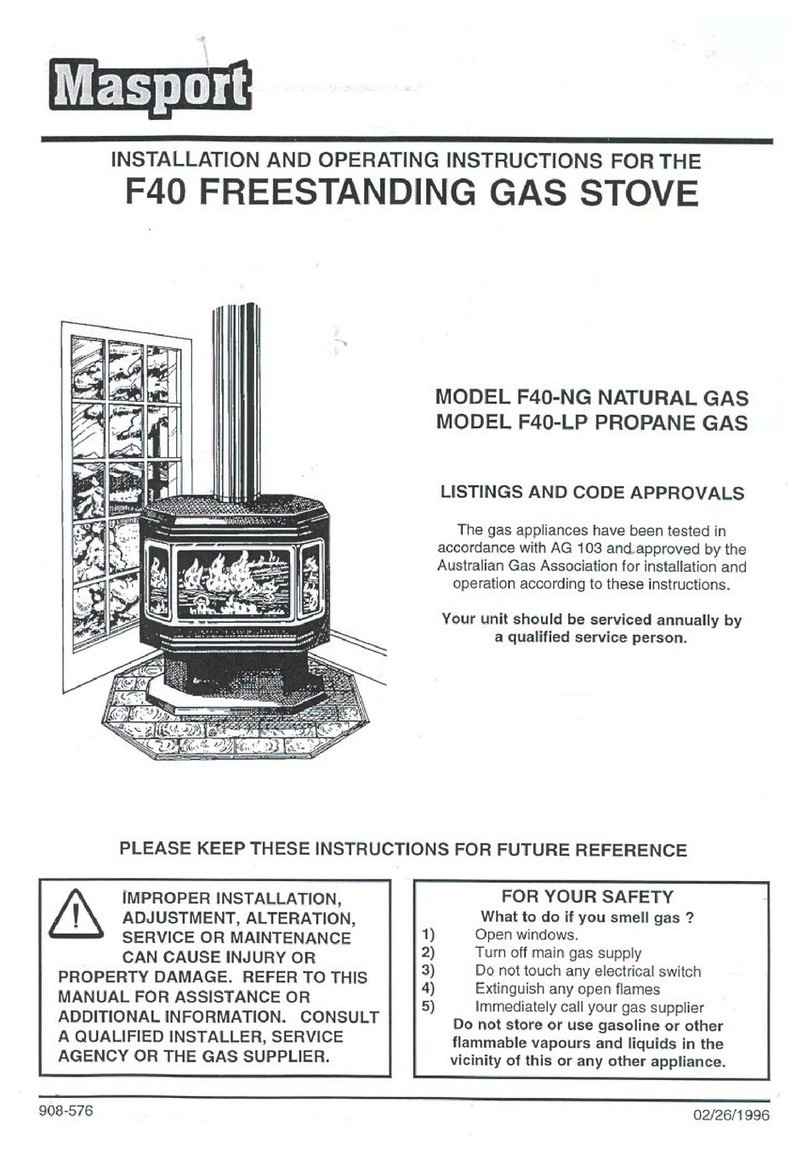
Masport
Masport F40 Installation and operating instructions
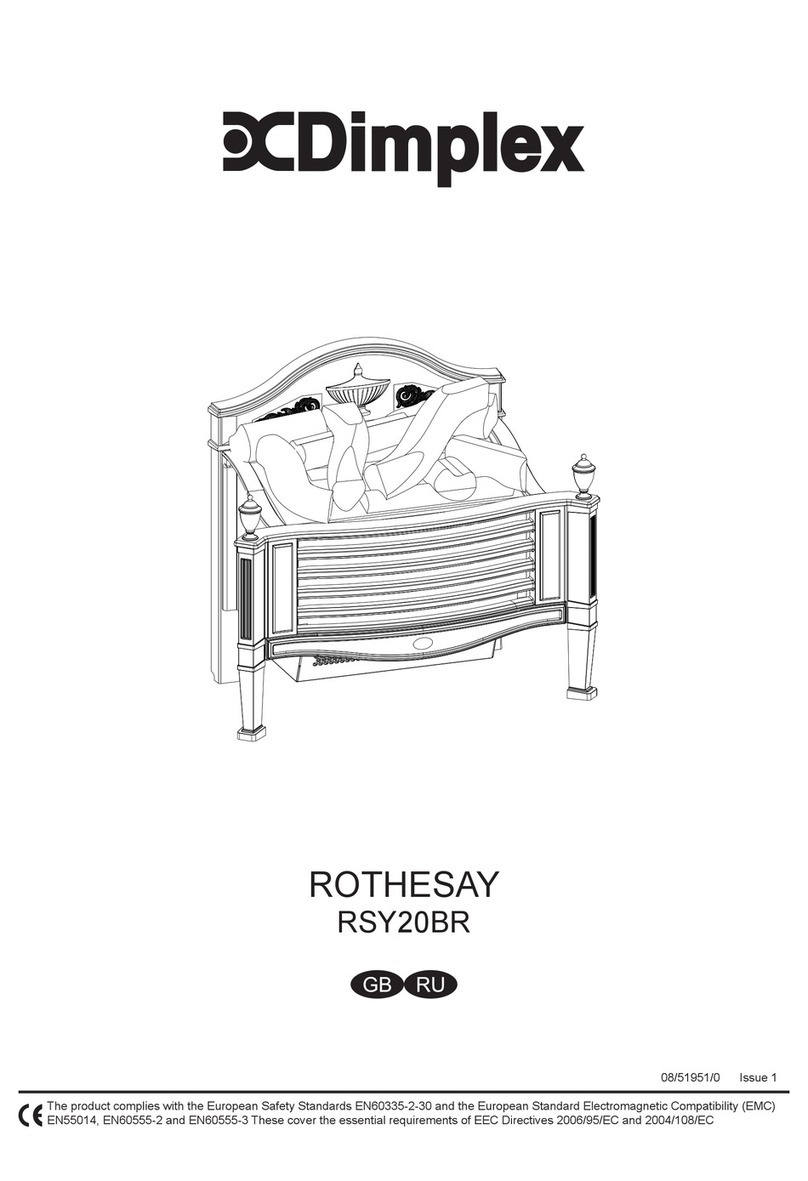
Dimplex
Dimplex ROTHESAY RSY20BR manual
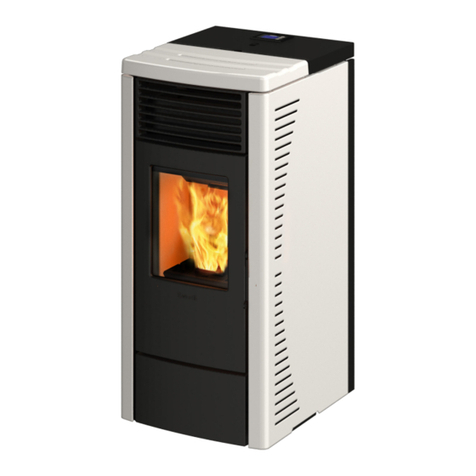
Ravelli
Ravelli Francesca 2015 brochure
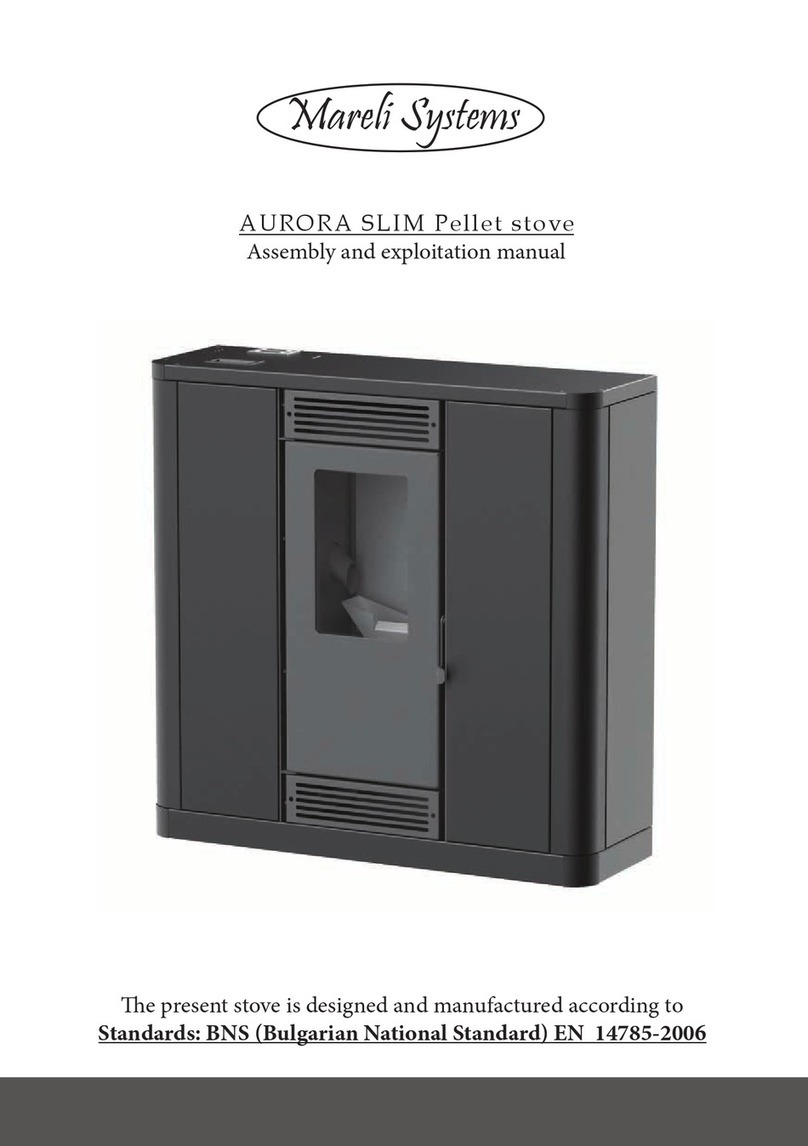
Mareli Systems
Mareli Systems AURORA SLIM Assembly and exploitation manual

Hunter
Hunter Double Herald 14 CE Installation and operating instructions
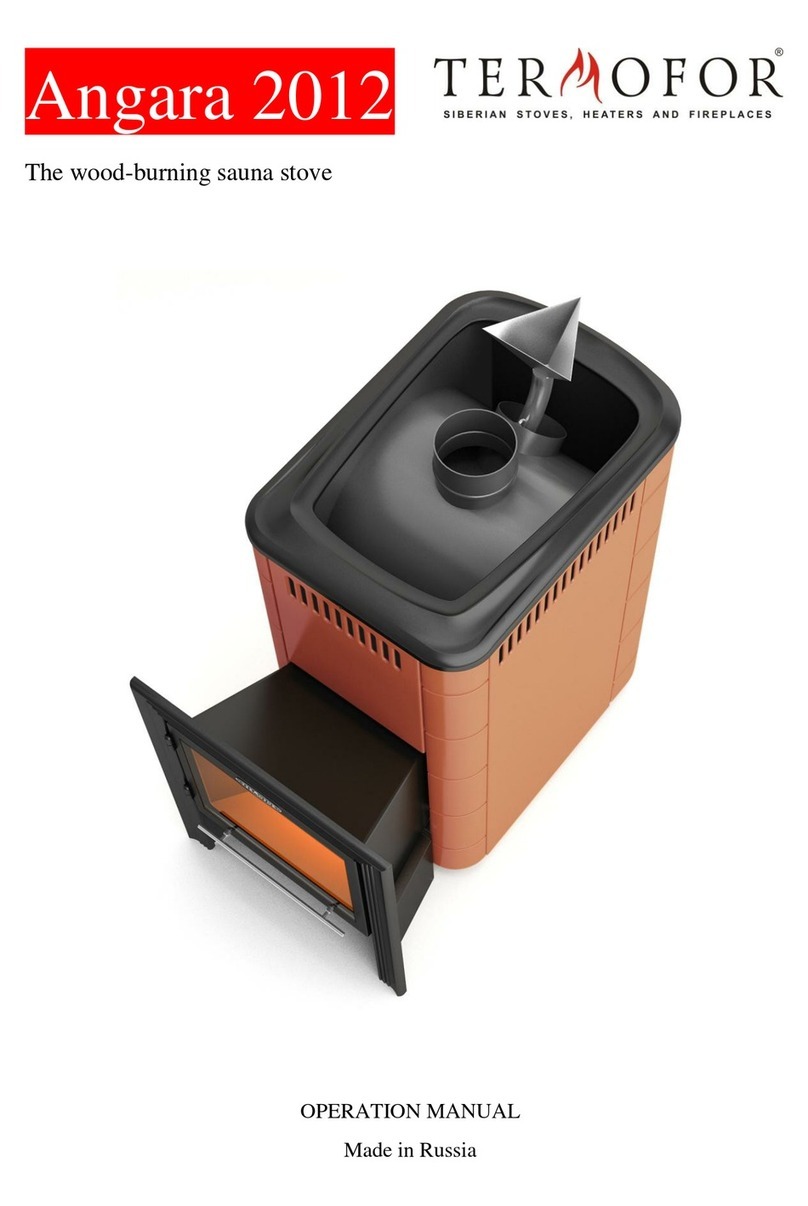
Termofor
Termofor Angara 2012 Operation manual

Travis Industries
Travis Industries 99300687 installation instructions

United States Stove Company
United States Stove Company Logwood 1261 owner's manual

Ashley
Ashley AW2520E-P Owner’s Instruction and Operation Manual
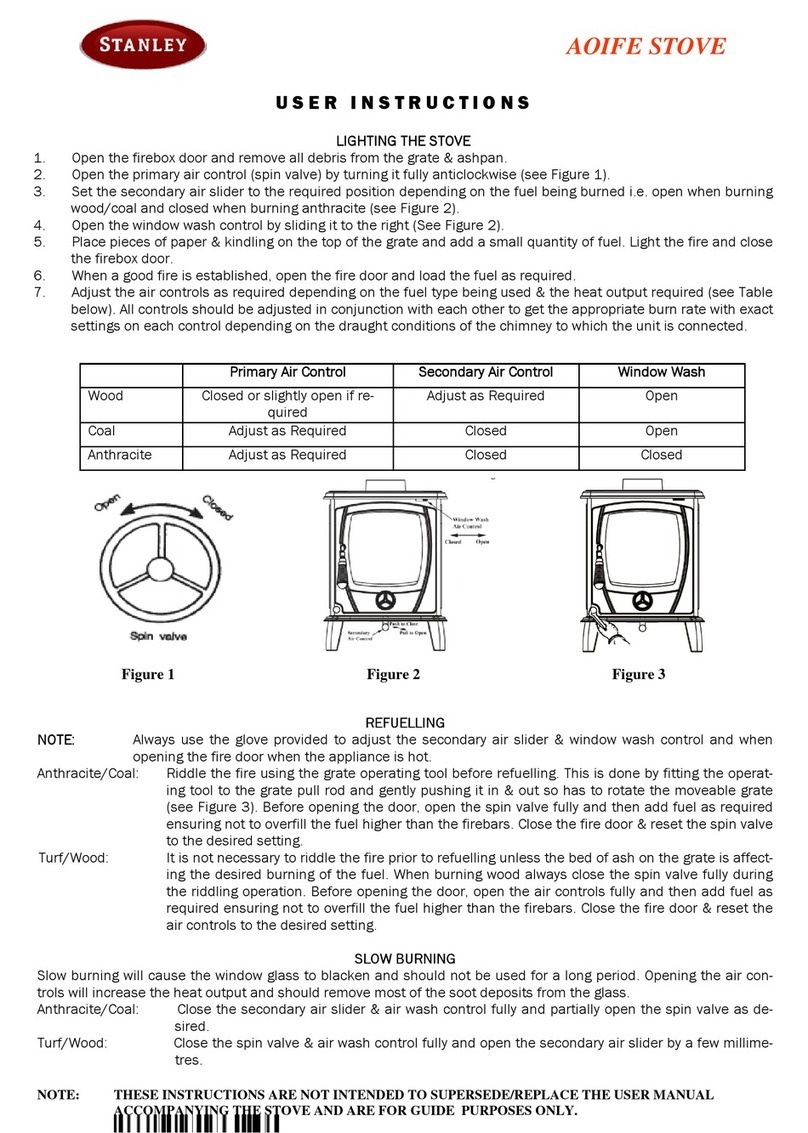
Stanley
Stanley Aoife User instructions
